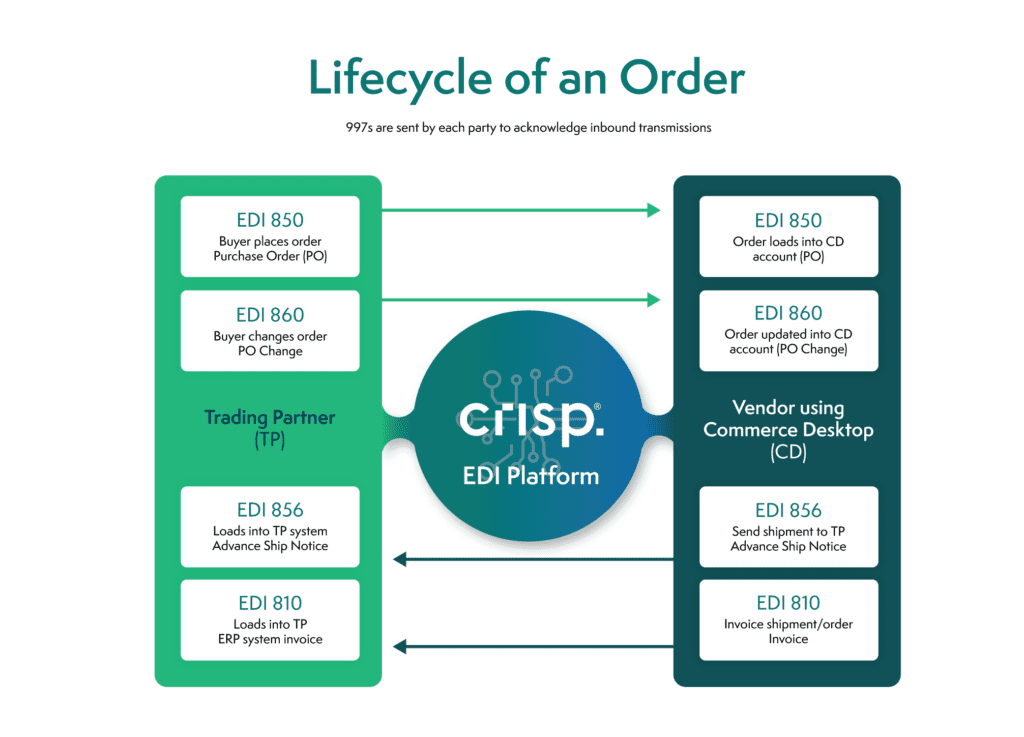The order management lifecycle
Some things are better when people can do their own thing… but generally, business processes do not fall into that category. Structured predictability, while it can feel restrictive on the one hand, brings a needed sense of order and transparency that far outweighs any downside.
EDI (Electronic Data Interchange) is one of the foremost examples of a standardized business process that keeps all parties on the same page and well-informed. At each step in the Order Management Process, there are clearly defined documents required to be exchanged by both the buyer (usually the Trading Partner) and the vendor. With EDI, no one is left hanging, wondering what’s happening. It is worth noting, too, that all major retailers mandate EDI. Although a huge machine is behind EDI — infrastructure, complex code, diverse skills — the users get a delightfully simple, predefined system.
It's worth looking at the basic life cycle of an order to illustrate the process. Note, however, that every specific Trading Partner has their own requirements, and this overview should not be substituted for any Trading Partner specific data flow.
If you have questions about the data flow for a Trading Partner that you deal with, don’t hesitate to reach out to us for more information.
The image below shows a simplified life cycle of an order. The Purchase Order (PO - EDI 850) is generated by your Trading Partner, and the data is transferred to our Crisp EDI Portal and loaded into your account. You can see the PO data in an easily readable format on the portal. On your behalf, we automatically send a Functional Acknowledgment (EDI 997) back to your Trading Partner. Similarly, when you issue your Invoice (EDI 810), it is loaded directly into your Trading Partners ERP system and acknowledged. You can see the status of an order in real-time on the Crisp EDI Portal: No surprises.
The specific documents to be exchanged are predetermined at the beginning of the relationship, and any alterations are documented in advance by your Trading Partner, and Crisp stays current with updates and changes.
With that said, there is some front-end setup, including testing and verification, that needs to happen for you to do EDI. The good news for you is that Crisp takes care of all of the setups so that when you are ready to go-live with your first Purchase Order, everything is in place and ready to go. We help ensure you send precisely the documents your Trading Partner requires at the right time and in the correct format. From Purchase Order to Invoice, there is a predictable flow of information and results.
If you’d like to make your life a little easier and be EDI compliant and poised to do business with major retailers, contact us to discuss how Crisp can help.
Contact our team
(289) 301-2410
edisales@gocrisp.com

Explanation of the documents in this graphic:
#1 -Transaction
Purchase Order (PO) – EDI 850
From Buyer to Vendor
This replaces paper PO used to place an order for goods or services. Like all EDI transactions, it is organized into standardized data segments. It contains the information you’d usually find on a PO:
- Items ordered and the price(s)
- Quantities
- Payment terms
- Shipping and carrier instructions
Functional Acknowledgement - EDI 997
From Vendor to Buyer
After each transaction, a Functional Acknowledgement (EDI 997) is sent in response. It notifies the original document sender of receipt of the EDI transaction into the receiver’s EDI system and confirms that it passed EDI mapping validation.
#2 - Transaction
Purchase Order Change – EDI 860
From Buyer to Vendor
This document allows the buyer to modify a purchase order already sent. Again, this is a formal process that allows both the buyer and the vendor to know what is expected: No concerns about lost emails or missed voicemails changing order details for such things as:
- Change items or quantity
- Change dates
- Change price
- Add items
Functional Acknowledgement - EDI 997
From Vendor to Buyer
#3 - Transaction
Advance Ship Notice (ASN) - EDI 856
From Vendor to Buyer
This document advises the Trading Partner that the order they placed (PO) is underway and provides advance notice of when it will arrive at the specified delivery location. Once the shipment has been delivered, the barcoded labels can result in faster and more efficient receiving of goods.
Functional Acknowledgement - EDI 997
From Buyer to Vendor
#4 - Transaction
Invoice – EDI 810
From Vendor to Buyer
The order has come full circle, the buyer has the goods ordered, and the vendor can request payment. The Invoice typically includes the following:
- Invoice number and date
- Order information (goods requested in PO)
- Shipping date
- Payment Terms
Functional Acknowledgement - EDI 997
From Buyer to Vendor
Get insights from your retail data
Crisp connects, normalizes, and analyzes disparate retail data sources, providing CPG brands with up-to-date, actionable insights to grow their business.